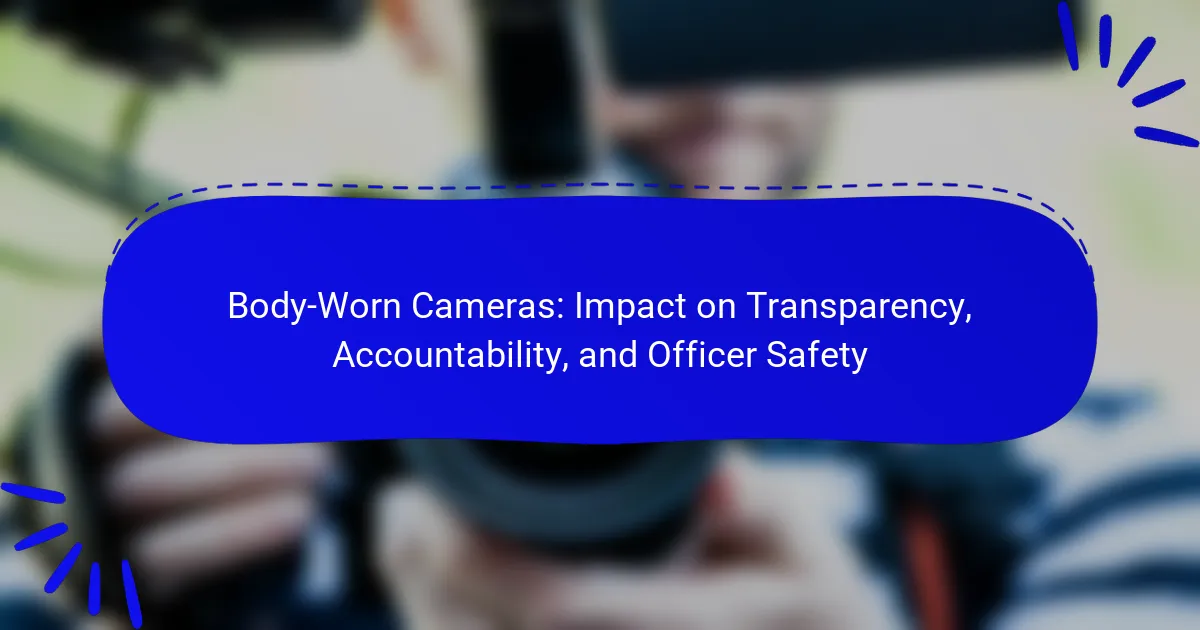
What are Body-Worn Cameras and their Purpose?
Body-worn cameras are recording devices worn by law enforcement officers. They capture video and audio of interactions with the public. The primary purpose of these cameras is to enhance transparency and accountability in policing. They provide an objective record of events during encounters. Studies show that their use can lead to a reduction in complaints against officers. Additionally, they can improve evidence collection for investigations and court cases. According to a 2018 study by the Police Foundation, body-worn cameras have been linked to increased officer safety. Overall, body-worn cameras serve to foster trust between the community and law enforcement.
How do Body-Worn Cameras function in law enforcement?
Body-worn cameras function in law enforcement by recording audio and video during police interactions. These devices are typically mounted on an officer’s uniform. They capture real-time footage of incidents, providing a visual account of events. The recordings can be used as evidence in investigations and court proceedings. Body-worn cameras also promote accountability among officers and transparency within the police force. Studies indicate that their use can lead to a reduction in complaints against officers. Additionally, they enhance officer safety by documenting interactions with the public. This technology supports a more objective assessment of police conduct.
What technology is used in Body-Worn Cameras?
Body-worn cameras utilize several key technologies. These include high-definition video recording, digital storage, and wireless connectivity. High-definition video recording allows for clear image capture in various lighting conditions. Digital storage enables the preservation of recorded footage for later review. Wireless connectivity facilitates real-time data transfer to secure servers. Many body-worn cameras also feature GPS tracking for location data. Additionally, some models incorporate night vision technology for low-light situations. These technologies collectively enhance transparency and accountability in law enforcement.
How is footage recorded and stored from Body-Worn Cameras?
Footage from body-worn cameras is recorded digitally onto internal storage devices. These devices often use flash memory to store video files. The cameras typically capture video continuously or when activated manually. Recorded footage is usually encrypted to protect sensitive information. After recording, data is transferred to secure servers for storage and management. This transfer can occur wirelessly or via physical connection. Many systems also implement automatic data uploads when cameras are docked. Storage durations vary based on department policies and storage capacity.
What role do Body-Worn Cameras play in promoting transparency?
Body-worn cameras (BWCs) promote transparency by providing objective video evidence of police interactions. This evidence can clarify events during encounters between law enforcement and the public. BWCs enhance accountability by recording actions, which can be reviewed during investigations. Studies indicate that transparency increases public trust in law enforcement. For example, a 2018 study by the National Institute of Justice found that BWCs can reduce complaints against officers by about 93%. This reduction in complaints further supports the notion that BWCs foster a more transparent relationship between police and communities.
How do Body-Worn Cameras enhance public trust in law enforcement?
Body-worn cameras enhance public trust in law enforcement by increasing transparency and accountability. They provide a reliable record of interactions between police and the community. This documentation can help verify the accuracy of reports and claims made by both officers and civilians. Studies show that the presence of body-worn cameras can reduce incidents of misconduct. For instance, a study by the University of Cambridge found a 93% reduction in complaints against officers when cameras were used. Moreover, communities often feel more secure knowing that encounters are being recorded. This can lead to improved relationships between law enforcement and the public. Overall, body-worn cameras serve as a tool for fostering trust and credibility in policing.
What are the implications of Body-Worn Camera footage for public accountability?
Body-Worn Camera footage significantly enhances public accountability. This technology provides an objective record of police interactions with the public. It can deter misconduct by officers, knowing they are being recorded. A study by the University of California, Riverside found that body-worn cameras reduced complaints against officers by 88%. Additionally, footage can be used in investigations to clarify events and inform the public. Transparency increases when this footage is made accessible to the community. Overall, Body-Worn Cameras foster trust between law enforcement and the public by promoting accountability.
In what ways do Body-Worn Cameras contribute to officer safety?
Body-worn cameras enhance officer safety by providing real-time documentation of interactions. This accountability can deter aggressive behavior from suspects. Studies show that the presence of cameras reduces incidents of violence against officers. Officers feel more secure knowing their actions are recorded. This technology can also aid in evidence collection during confrontations. Additionally, video footage can clarify situations, reducing misunderstandings. A report from the Police Executive Research Forum indicates that departments with body-worn cameras see a decrease in complaints against officers. Overall, body-worn cameras serve as a protective measure for law enforcement personnel.
How can Body-Worn Cameras deter aggressive behavior towards officers?
Body-worn cameras can deter aggressive behavior towards officers by increasing accountability and transparency. When individuals know they are being recorded, they are less likely to engage in confrontational actions. Studies indicate that the presence of body-worn cameras reduces incidents of aggression. For example, a study by the Rialto Police Department found a 60% reduction in use-of-force incidents after implementing body-worn cameras. Additionally, the recorded footage can serve as evidence in investigations, further discouraging aggressive behavior. The awareness of monitoring creates a more respectful interaction between officers and the public.
What evidence exists to support the impact of Body-Worn Cameras on officer safety?
Body-worn cameras (BWCs) have been shown to enhance officer safety. Research indicates that the presence of BWCs can deter aggressive behavior from suspects. A study by Ariel et al. (2016) found a 60% reduction in use-of-force incidents when officers wore BWCs. Additionally, the National Institute of Justice reported that BWCs can improve accountability and reduce complaints against officers. These factors contribute to a safer environment for law enforcement personnel. The evidence suggests that BWCs play a crucial role in promoting officer safety through increased transparency and accountability.

What are the challenges associated with Body-Worn Cameras?
Challenges associated with body-worn cameras include privacy concerns, data management issues, and financial costs. Privacy concerns arise as footage may capture sensitive information about individuals. Data management issues involve storing, retrieving, and securing large volumes of video data. Financial costs encompass the initial purchase, maintenance, and storage of camera systems. Additionally, there may be operational challenges, such as ensuring consistent usage by officers. Legal complexities can arise regarding the admissibility of footage in court. Lastly, there is the potential for misuse of footage, leading to ethical dilemmas.
What privacy concerns arise from the use of Body-Worn Cameras?
Privacy concerns from the use of Body-Worn Cameras include potential violations of individual privacy rights. The cameras can capture sensitive interactions, including private conversations and personal moments. This raises issues about consent, as individuals may not be aware they are being recorded. Additionally, footage may be misused or accessed by unauthorized personnel. There is also a risk of data breaches, leading to unauthorized exposure of recorded material. The retention policies for recorded data can further complicate privacy issues, as extended storage increases the likelihood of misuse. Studies indicate that these concerns can undermine public trust in law enforcement.
How is sensitive information managed in Body-Worn Camera footage?
Sensitive information in Body-Worn Camera footage is managed through strict access controls and data redaction processes. Law enforcement agencies implement policies to restrict access to footage containing sensitive data. This includes personal information of individuals captured in the footage. Redaction is performed to obscure faces and other identifying details before footage is released to the public or external parties.
Additionally, many jurisdictions have protocols that determine the retention period for footage containing sensitive information. This ensures that such footage is not kept longer than necessary. Compliance with legal standards, such as privacy laws, is also a key factor in managing sensitive information. These measures help protect individual privacy while balancing transparency and accountability in law enforcement practices.
What policies are in place to protect individual privacy rights?
Policies protecting individual privacy rights include regulations that govern the use of body-worn cameras (BWCs) by law enforcement. These policies often require that recordings are made with respect to individuals’ privacy, particularly in sensitive situations. For example, many jurisdictions mandate that officers must turn off cameras when entering private residences unless there is explicit consent from the occupants. Additionally, policies may stipulate restrictions on accessing and sharing footage, ensuring that it is only available for legitimate law enforcement purposes. Some laws also provide individuals with the right to request deletion of footage that captures them in private settings. These measures aim to balance transparency and accountability in policing while safeguarding personal privacy rights.
How do Body-Worn Cameras affect police-community relations?
Body-worn cameras (BWCs) positively affect police-community relations by enhancing transparency and accountability. The presence of BWCs can lead to improved trust between law enforcement and community members. Studies have shown that communities perceive police actions as more legitimate when recorded. For example, a study by Ariel et al. (2016) found that BWCs reduced complaints against officers by 93%. Additionally, BWCs provide objective evidence during interactions, which can help resolve disputes. This evidence can also promote fair treatment and reduce instances of misconduct. Overall, BWCs serve as a tool for fostering mutual respect and understanding between police and the communities they serve.
What feedback have communities provided regarding Body-Worn Cameras?
Communities have provided mixed feedback regarding Body-Worn Cameras (BWCs). Many community members express support for BWCs, citing increased transparency in police interactions. They believe BWCs can enhance accountability for law enforcement actions. Some communities report feeling safer knowing that interactions are recorded. However, concerns exist about privacy and the potential misuse of footage. Certain individuals worry about the impact of BWCs on police behavior, fearing it may lead to increased aggression. Research indicates that public perception of BWCs varies significantly across different demographics. Overall, community feedback reflects both positive and negative sentiments about BWCs.
How can Body-Worn Cameras be used to foster dialogue between police and the public?
Body-worn cameras can enhance dialogue between police and the public by promoting transparency. These devices capture interactions, providing a clear record of events. This transparency helps build trust between law enforcement and community members. When citizens can view recorded footage, they gain insights into police actions. This fosters open discussions about policing practices and community concerns. Research indicates that communities with body-worn camera programs report improved perceptions of police accountability. Furthermore, these cameras can serve as a tool for training officers in community engagement. Overall, body-worn cameras facilitate constructive conversations by providing factual evidence of police conduct.

What are the best practices for implementing Body-Worn Cameras?
Best practices for implementing body-worn cameras include establishing clear policies and procedures. These policies should define when cameras should be activated and deactivated. Training for officers on proper usage is essential. This training should cover technical operation and legal considerations. Data storage protocols must be established to ensure secure and accessible footage. Regular audits of camera usage and footage can enhance accountability. Engaging with community stakeholders fosters transparency and public trust. Lastly, reviewing and updating policies regularly keeps practices aligned with technological advancements and community needs.
What guidelines should law enforcement agencies follow when adopting Body-Worn Cameras?
Law enforcement agencies should follow specific guidelines when adopting Body-Worn Cameras (BWCs). These guidelines include establishing clear policies on when to activate and deactivate the cameras. Agencies must also ensure compliance with legal standards for privacy and data retention. Training for officers on BWC usage is essential to maximize effectiveness.
Additionally, agencies should engage with the community to address concerns and expectations regarding BWCs. Regular audits of BWC footage can help maintain accountability and transparency. Agencies should also invest in secure data storage solutions to protect recorded footage. Evaluating the impact of BWCs on policing practices is crucial for ongoing improvement.
These guidelines are supported by studies indicating that proper implementation of BWCs enhances accountability and public trust in law enforcement.
How can training improve the effectiveness of Body-Worn Cameras?
Training can significantly enhance the effectiveness of Body-Worn Cameras (BWCs). Proper training ensures officers understand how to operate BWCs effectively. It increases their awareness of when to activate the cameras during critical incidents. Trained officers are more likely to capture relevant footage, improving evidence quality. Additionally, training can address legal and ethical considerations surrounding BWC usage. Knowledge of policies can prevent misuse and enhance accountability. Studies indicate that departments with comprehensive training programs report higher satisfaction with BWC implementation. A 2018 report by the Police Executive Research Forum found that effective training correlates with better footage quality and officer compliance.
What role do policies play in the successful implementation of Body-Worn Cameras?
Policies are crucial for the successful implementation of Body-Worn Cameras (BWCs). They establish clear guidelines on usage, data management, and privacy protection. These policies ensure that officers understand when and how to activate the cameras. They also dictate the protocols for data storage and access, promoting accountability. Additionally, policies help to address public concerns regarding surveillance and civil liberties. Studies show that departments with well-defined policies report higher levels of officer compliance and community trust. For instance, a report by the Bureau of Justice Assistance highlights that effective policies lead to improved transparency and accountability in law enforcement.
What future trends can we expect in Body-Worn Camera technology?
Future trends in body-worn camera technology include enhanced video quality and artificial intelligence integration. Cameras are expected to feature 4K resolution, providing clearer images for evidence. AI will assist in real-time analysis, identifying critical incidents as they happen. Increased storage capacity will allow longer recording times without frequent data management. Wireless connectivity will enable immediate data transfer to cloud storage for secure access. Improved battery life will ensure cameras remain operational during extended shifts. Additionally, privacy features will evolve, allowing for selective recording to protect sensitive information. These trends aim to enhance transparency and accountability in law enforcement.
How might advancements in technology enhance Body-Worn Cameras?
Advancements in technology can enhance body-worn cameras by improving video quality, battery life, and data management. Enhanced video quality allows for clearer images, which aids in evidence collection. High-definition recording capabilities can capture finer details during incidents. Extended battery life ensures that cameras remain operational for longer periods, reducing the risk of missing critical events. Improved data management systems facilitate easier storage and retrieval of footage. Cloud integration allows for secure, remote access to recorded data. Advanced analytics can provide real-time insights and alerts during incidents. These technological improvements contribute to increased transparency and accountability in law enforcement.
What potential changes in legislation could impact Body-Worn Camera use?
Potential changes in legislation could include new privacy laws affecting data collection. These laws may restrict how body-worn camera footage is stored and accessed. Additionally, legislation could mandate the use of body-worn cameras in all law enforcement agencies. Such requirements could standardize practices across jurisdictions. Changes in public records laws may also influence the release of footage to the public. Laws governing the use of force could impact when cameras must be activated. Finally, funding legislation could affect the availability of resources for body-worn camera programs. Each of these changes could significantly alter the operational landscape for body-worn cameras in law enforcement.
What are the key takeaways for law enforcement agencies regarding Body-Worn Cameras?
Body-worn cameras (BWCs) enhance transparency and accountability for law enforcement agencies. They provide objective evidence in critical incidents, reducing disputes about police conduct. BWCs can improve community trust by demonstrating commitment to transparency. The use of BWCs has been linked to a decrease in complaints against officers. Studies show that incidents of excessive force may decline with BWC implementation. Training on proper use and policies is essential for effective BWC deployment. Agencies should establish clear guidelines on data management and privacy concerns. Regular audits of BWC footage can ensure compliance and maintain accountability.
Body-worn cameras (BWCs) are recording devices utilized by law enforcement to capture audio and video of police interactions, aimed at enhancing transparency and accountability in policing. This article explores the functionality, technology, and implications of BWCs, highlighting their role in promoting public trust and officer safety. It discusses the management of sensitive information, privacy concerns, and the challenges associated with BWC implementation. Additionally, the article outlines best practices for adopting BWCs and examines future trends that may impact their use in law enforcement. Key findings indicate that BWCs can significantly reduce complaints against officers and improve community relations.
